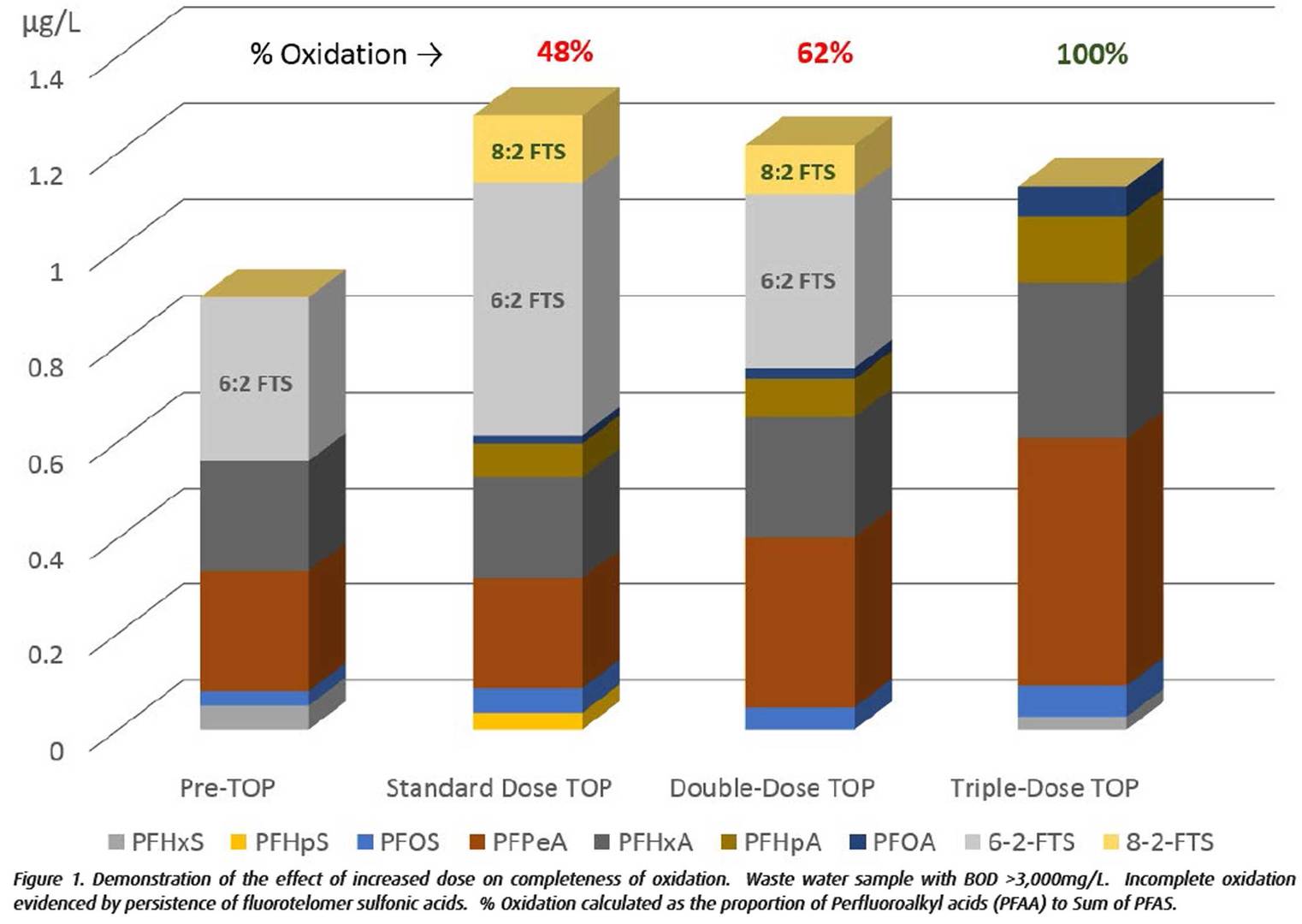EnviroMail 07 Canada
TOP Assay Challenges and Developments
The Total Oxidizable Precursor (TOP) Assay is an oxidative sample pre-treatment method aimed at converting the PFAS (Perfuoroalkyl Substances) within a sample into the stable perfluoroalkyl acids that can be quantified by conventional LC/MS/MS analytical techniques, thereby providing a greater understanding of the extent of PFAS within a sample. The oxidation is achieved by hydroxyl radicals, formed under heated alkaline conditions from prescribed amounts of potassium persulfate (KPS) and sodium hydroxide (NaOH) added to the sample prior to incubation.

Challenges with Current Methodology
Extensive testing on a diverse range of firefighting foam products has been completed by ALS Australia in collaboration with Arcadis Australia and has demonstrated that under the standard conditions of the assay, exhaustion of the oxidant (hydroxyl radicals) is possible unless samples are pre-diluted.
The primary source of exhaustion is not through conversion of PFAS, but from competition by other oxidizable material present in the formulations. This material is typically present at higher proportions than the PFAS (i.e. solvents, non-fluorinated hydrocarbon surfactants, and polysaccharide or protein thickeners, as found in alcohol-resistant foams).
For environmental samples, exhaustion of the oxidant has been observed in matrices with elevated levels of organic carbon. Incomplete oxidation is evidenced by the persistence of fluorotelomers post-assay (rather than the expected conversion to perfluorinated carboxylic acids) and the formation of fluorotelomer sulfonic acids from fluorotelomer sulfonamide derivatives (evidence of alkaline hydrolysis). Incomplete oxidation may significantly underestimate the post-assay PFAS concentration where substantial concentrations of “precursor” compounds are present.
Method and LOR Information
ALS Method Code
- PFAS-DI - Short Suite (PFOS and PFOA)
- PFAS-DI-EX - Full Suite (28 Analytes)
- PFAS-TOPA-DI - TOP Assay (28 Analytes)
- PFAS-LL - Low Level Short Suite
- PFAS-LL-EX - Low Level Full Suite
- PFAS-TOPA-LL - TOP Assay Full Suite
- PFAS-OMNIBUS - BC CSR Omnibus (3 Analytes)
- PFAS-HEALTHCAN - Health Canada Screening Guideline (9 Analytes)
Limit of Detection
Water
- PFAS-DI, PFAS-DI-EX, PFAS-TOPA-DI - 0.01-0.05 µg/L
- PFAS-LL, PFAS-LL-EX, PFAS-TOPA-LL - 0.001-0.005 µg/L
Soil
- PFAS-LL, PFAS-LL-EX, PFAS-TOPA-LL - 0.001-0.01 mg/kg
Total Oxidizable Precursor (TOP) Assay Developments
Previously, the only solution to avoiding incomplete oxidation was pre-dilution of the sample to reduce interference from the non-PFAS oxidizable material. However, dilution is only useful if the raised limits of reporting permit practical data interpretation and assessment against relevant criteria.
ALS Australia has recently completed a collaborative investigation with Arcadis Australia and carried out extensive verification using increased dosage of oxidant for TOP Assay. Of critical importance in this modified technique is maintaining the stoichiometric ratio of oxidant (KPS) to hydroxide (NaOH). Also crucial is ensuring the pH is maintained within a range that promotes effective propagation of hydroxyl radicals and that avoids potential chain shortening. Shortening of the perfluorinated alkyl chain below C4 will be unaccounted for, as this is the shortest chain length detected in the current analytical suite.
Wastewater samples from a confidential project with high BOD concentrations (>3,000 mg/L) had consistently demonstrated incomplete oxidation under standard dose conditions. This was evidenced by the persistence of fluorotelomer sulfonic acids following the oxidation step. As shown in Figure 1 (below), through increased oxidant dosage, effective conversion was achieved. The option of increasing dosage on difficult matrices provides benefits in terms of reduced frequency of repeats (and associated reporting delays) as well as preservation of limits of reporting. Ultimately a combined approach of dilution and increased dosage may be required for particularly challenging matrices in order to meet practical reporting requirements. In such instances, understanding the data objectives of the project is key.

Acknowledgement
ALS would like to acknowledge Arcadis for technical input on method development and for use of project data.References
Erika F. Houtz and David L. Sedlak, Environ. Sci. Technol. 2012, 9342-9349Download as a PDF
Other ALS EnviroMails about PFAS
EnviroMail 01: Perfluoroaklyl Substances (PFAS)
EnviroMail 02: Total Oxidizable Precursor (TOP) Assay





















































